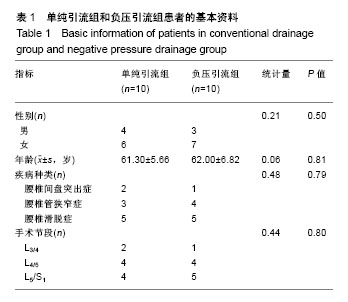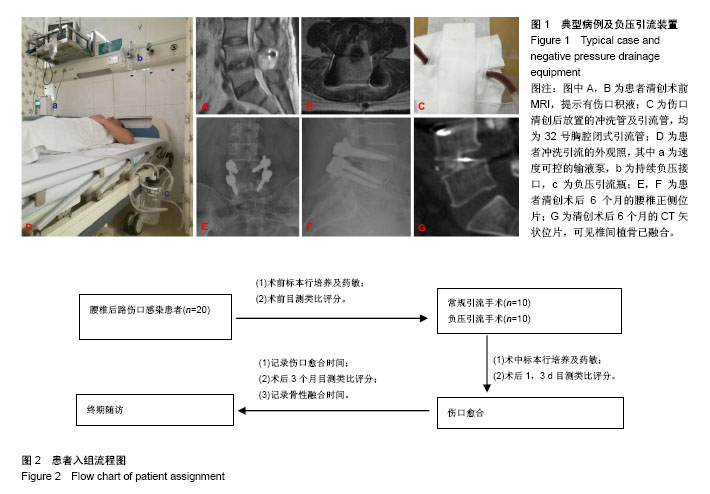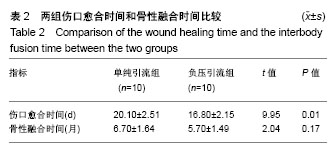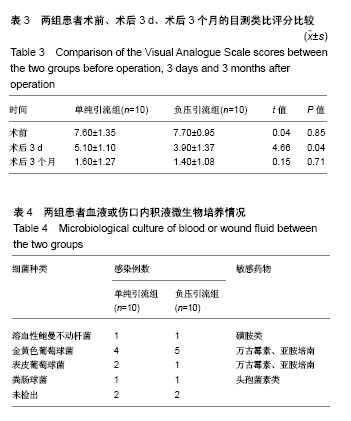| [1] Cancienne JM, Werner BC, Chen DQ, et al. Perioperative hemoglobin A1c as a predictor of deep infection following single-level lumbar decompression in patients with diabetes. Spine J. 2017;17(8): 1100-1105.
[2] Klemencsics I, Lazary A, Szoverfi Z, et al. Risk factors for surgical site infection in elective routine degenerative lumbar surgeries. Spine J. 2016;16(11):1377-1383.
[3] 黄帅豪,柯雨洪,王义生,等. 腰椎后路内固定术后感染的原因分析与治疗体会[J]. 中国矫形外科杂志,2014,22(21): 2002-2005.
[4] 丁凡,邵增务,吴宏斌. 外固定器结合封闭负压引流技术治疗胫腓骨骨折术后感染[J]. 中国矫形外科杂志,2010,18(8): 645-648.
[5] 孔德明,银晓勇,张磊. 高负压封闭引流技术在脊柱术后感染中的应用[J].实用骨科杂志,2009, 15(8):603-604.
[6] Liu X, Liang J, Zao J, et al. Vacuum sealing drainage treatment combined with antibiotic-impregnated bone cement for treatment of soft tissue defects and infection. Med Sci Monit. 2016;22:1959-1965.
[7] Wang J, Zhang H, Wang S. Application of vacuum sealing drainage in the treatment of internal fixation instrument exposure after early postoperative infection. Minerva Chir. 2015;70(1):17-22.
[8] 王许可,宋仁谦,周英杰,等. 保留内置物清创术联合真空负压封闭引流治疗脊柱术后早发性感染[J].中国脊柱脊髓杂志, 2015,25(12):1123-1125.
[9] 高志强,李洋,罗飞,等. 对脊柱椎间融合的影像学评价策略[J]. 中国组织工程研究,2015,19(48): 7825-7830.
[10] Lee JJ, Odeh KI, Holcombe SA, et al. Fat thickness as a risk factor for infection in lumbar spine surgery. Orthopedics. 2016;39(6): e1124-e1128.
[11] Blumberg TJ, Woelber E, Bellabarba C, et al. Predictors of increased cost and length of stay in the treatment of postoperative spine surgical site infection. Spine J. 2017 Jul 21. doi: 10.1016/j.spinee.2017.07.173. [Epub ahead of print]
[12] Ojo OA, Owolabi BS, Oseni AW, et al. Surgical site infection in posterior spine surgery. Niger J Clin Pract. 2016;19(6):821-826.
[13] Salvetti DJ, Tempel ZJ, Gandhoke GS, et al. Preoperative prealbumin level as a risk factor for surgical site infection following elective spine surgery. Surg Neurol Int. 2015;6(Suppl 19):S500-503.
[14] Abdallah DY, Jadaan MM, McCabe JP. Body mass index and risk of surgical site infection following spine surgery: a meta-analysis. Eur Spine J. 2013;22(12):2800-2809.
[15] Caputo AM, Dobbertien RP, Ferranti JM, et al. Risk factors for infection after orthopaedic spine surgery at a high-volume institution. J Surg Orthop Adv. 2013;22(4):295-298.
[16] Iwata E, Shigematsu H, Koizumi M, et al. Lymphopenia and elevated blood C-reactive protein levels at four days postoperatively are useful markers for early detection of surgical site infection following posterior lumbar instrumentation surgery. Asian Spine J. 2016;10(2):220-225.
[17] 刘少强,齐强,陈仲强,等. 临床诊断与病原确诊脊柱术后感染的临床特征对比[J]. 中国矫形外科杂志,2016,24(11):1006-1009.
[18] Hobusch GM, Bodner F, Walzer S, et al. C-reactive protein as a prognostic factor in patients with chordoma of lumbar spine and sacrum--a single center pilot study. World J Surg Oncol. 2016;14:111.
[19] Choi MK, Kim SB, Kim KD, et al. Sequential changes of plasma C-reactive protein, erythrocyte sedimentation rate and white blood cell count in spine surgery : comparison between lumbar open discectomy and posterior lumbar interbody fusion. J Korean Neurosurg Soc. 2014; 56(3):218-223.
[20] Wang B, Fintelmann FJ, Kamath RS, et al. Limited magnetic resonance imaging of the lumbar spine has high sensitivity for detection of acute fractures, infection, and malignancy. Skeletal Radiol. 2016;45(12):1687-1693.
[21] Torres C, Zakhari N. Imaging of spine infection. Semin Roentgenol. 2017;52(1):17-26.
[22] Wang B, Fintelmann FJ, Kamath RS, et al. Limited magnetic resonance imaging of the lumbar spine has high sensitivity for detection of acute fractures, infection, and malignancy. Skeletal Radiol. 2016;45(12):1687-1693.
[23] Mazzie JP, Brooks MK, Gnerre J. Imaging and management of postoperative spine infection. Neuroimaging Clin N Am. 2014;24(2): 365-374.
[24] 刘少强,齐强,陈仲强,等.影响脊柱术后感染内固定移除的因素分析[J].中国矫形外科杂志,2014,22(6): 552-554.
[25] Tominaga H, Setoguchi T, Kawamura H, et al. Risk factors for unavoidable removal of instrumentation after surgical site infection of spine surgery: A retrospective case-control study. Medicine (Baltimore). 2016;95(43):e5118.
[26] Lee JS, Ahn DK, Chang BK, et al. Treatment of surgical site infection in posterior lumbar interbody fusion. Asian Spine J. 2015;9(6):841-848.
[27] 闰廷飞,孙晨曦,杨勇,等. 腰椎内固定术后感染的临床研究[J]. 中华骨科杂志,2016, 36(22):1463-1468.
[28] Chaichana KL, Bydon M, Santiago-Dieppa DR, et al. Risk of infection following posterior instrumented lumbar fusion for degenerative spine disease in 817 consecutive cases. J Neurosurg Spine. 2014;20(1):45-52.
[29] 林旭,谭伦,曾俊,等. 保留内固定植入物治疗胸腰椎术后感染[J].中国组织工程研究,2015,19(4):537-542.
[30] Fei J, Gu J. Comparison of lavage techniques for preventing incision infection following posterior lumbar interbody fusion. Med Sci Monit. 2017;23:3010-3018.
[31] 田纪伟,谭炳毅,李家顺,等.椎弓根螺钉系统内固定术后迟发感染的处理[J].脊柱外科杂志,2004,2(5):297-298.
[32] 庞再力,庄瑞卓,肖建生,等.应用单管闭式引流冲洗技术治疗各种复杂的骨科感染[J].吉林医学,2013,34(20):4079-4080.
[33] Pullter Gunne AF, Cohen DB. Incidence, prevalence, and analysis of risk factors for surgical site infection following adult spinal surgery. Spine (Phila Pa 1976). 2009;34(13):1422-1428. |
.jpg)




.jpg)